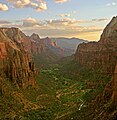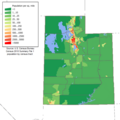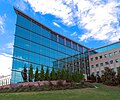Portal:Utah
The Utah Portal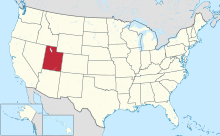  Utah (/ˈjuːtɑː/ YOO-tah, /ˈjuːtɔː/ YOO-taw; Navajo: Áshįįh Biiʼtó Hahoodzo) is a landlocked state in the Mountain West subregion of the Western United States. It borders Colorado to its east, Wyoming to its northeast, Idaho to its north, Arizona to its south, and Nevada to its west. Utah also touches a corner of New Mexico in the southeast. Of the fifty U.S. states, Utah is the 13th-largest by area; with a population over three million, it is the 30th-most-populous and 11th-least-densely populated. Urban development is mostly concentrated in two areas: the Wasatch Front in the north-central part of the state, which is home to roughly two-thirds of the population and includes the capital city, Salt Lake City; and Washington County in the southwest, with more than 180,000 residents. Most of the western half of Utah lies in the Great Basin. Utah has been inhabited for thousands of years by various indigenous groups such as the ancient Puebloans, Navajo, and Ute. The Spanish were the first Europeans to arrive in the mid-16th century, though the region's difficult geography and harsh climate made it a peripheral part of New Spain and later Mexico. Even while it was Mexican territory, many of Utah's earliest settlers were American, particularly Mormons fleeing marginalization and persecution from the United States via the Mormon Trail. Following the Mexican–American War in 1848, the region was annexed by the U.S., becoming part of the Utah Territory, which included what is now Colorado and Nevada. Disputes between the dominant Mormon community and the federal government delayed Utah's admission as a state; only after the outlawing of polygamy was it admitted in 1896 as the 45th. People from Utah are known as Utahns. Slightly over half of all Utahns are Mormons, the vast majority of whom are members of the Church of Jesus Christ of Latter-day Saints (LDS Church), which has its world headquarters in Salt Lake City; Utah is the only state where a majority of the population belongs to a single church. The LDS Church greatly influences Utahn culture, politics, and daily life, though since the 1990s the state has become more religiously diverse as well as secular. (Full article...) Entries here consist of Good and Featured articles, which meet a core set of high editorial standards.
Since Utah became a U.S. state in 1896, it has sent congressional delegations to the United States Senate and United States House of Representatives. Each state elects two senators to serve for six years. Before the Seventeenth Amendment in 1913, senators were elected by the Utah State Legislature. Members of the House of Representatives are elected to two-year terms, one from each of Utah's four congressional districts. Before becoming a state, the Territory of Utah elected a non-voting delegate at-large to Congress from 1850 to 1896. 58 people have served either the Territory or State of Utah: 14 in the Senate, 42 in the House, and 2 in both houses. The average term for senators has been 15.3 years and the average term for representatives has been 6.7 years. The longest-serving senator was Orrin Hatch, from 1977 to 2019. The longest-serving representative is James V. Hansen, in office for 22 years from 1981 to 2003. No Utah women have served in the Senate, but five women - Reva Beck Bosone, Karen Shepherd, Enid Greene, Mia Love, and Celeste Maloy - have been Representatives. (Full article...)Selected image -June selected anniversaries
Selected biography -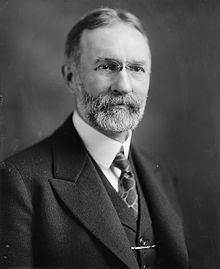 George Alexander Sutherland (March 25, 1862 – July 18, 1942) was an English-born American jurist and politician. He served as an associate justice of the U.S. Supreme Court between 1922 and 1938. As a member of the Republican Party, he also represented Utah in both houses of Congress. Born in Buckinghamshire, England, Sutherland and his family moved to the Utah Territory in the 1860s. After attending the University of Michigan Law School, Sutherland established a legal practice in Provo, Utah, and won election to the Utah State Senate. Sutherland won election to the United States House of Representatives in 1900 and to the United States Senate in 1905. In Congress, Sutherland supported several progressive policies but generally aligned with the party's conservative wing. He won re-election in 1911 but was defeated in the 1916 election by Democrat William H. King. (Full article...)Selected article -The historical buildings and structures of Zion National Park represent a variety of buildings, interpretive structures, signs and infrastructure associated with the National Park Service's operations in Zion National Park, Utah. Structures vary in size and scale from the Zion Lodge to road culverts and curbs, nearly all of which were designed using native materials and regional construction techniques in an adapted version of the National Park Service Rustic style. A number of the larger structures were designed by Gilbert Stanley Underwood, while many of the smaller structures were designed or coordinated with the National Park Service Branch of Plans and Designs. The bulk of the historic structures date to the 1920s and 1930s. Most of the structures of the 1930s were built using Civilian Conservation Corps labor. The version of the National Park Service Rustic style that was adopted at Zion was less extreme in its rustic character than that employed at other parks. Compared with the Bryce Canyon Lodge, the Zion Park Lodge used smaller elements of timber and stonework, and employed milled lumber in place of rough log elements. This reflected the more settled character of the Zion area, which retained farms and irrigation systems at the time the first visitor facilities were built. (Full article...)Did you know -
Selected panorama - Downtown Salt Lake City, Utah in 1913, looking east along 200 South from West Temple Street. To the far left is the Salt Lake Temple. The very white building right of the Temple is Hotel Utah, about one year old at the time. Just visible on the right side of the photo is the Salt Lake City and County Building clocktower. The Wasatch Mountains are in the background.
TopicsCategoriesGeneral imagesThe following are images from various Utah-related articles on Wikipedia.
State facts
State symbols:
Featured contentArticles:
Lists:
Pictures: Related portals
Lists
Related WikiProjectsNew articlesThis list was generated from these rules. Questions and feedback are always welcome! The search is being run daily with the most recent ~14 days of results. Note: Some articles may not be relevant to this project.
Rules | Match log | Results page (for watching) | Last updated: 2024-06-04 22:21 (UTC) Note: The list display can now be customized by each user. See List display personalization for details.
Things you can doAssociated WikimediaThe following Wikimedia Foundation sister projects provide more on this subject:
Discover Wikipedia using portals |





